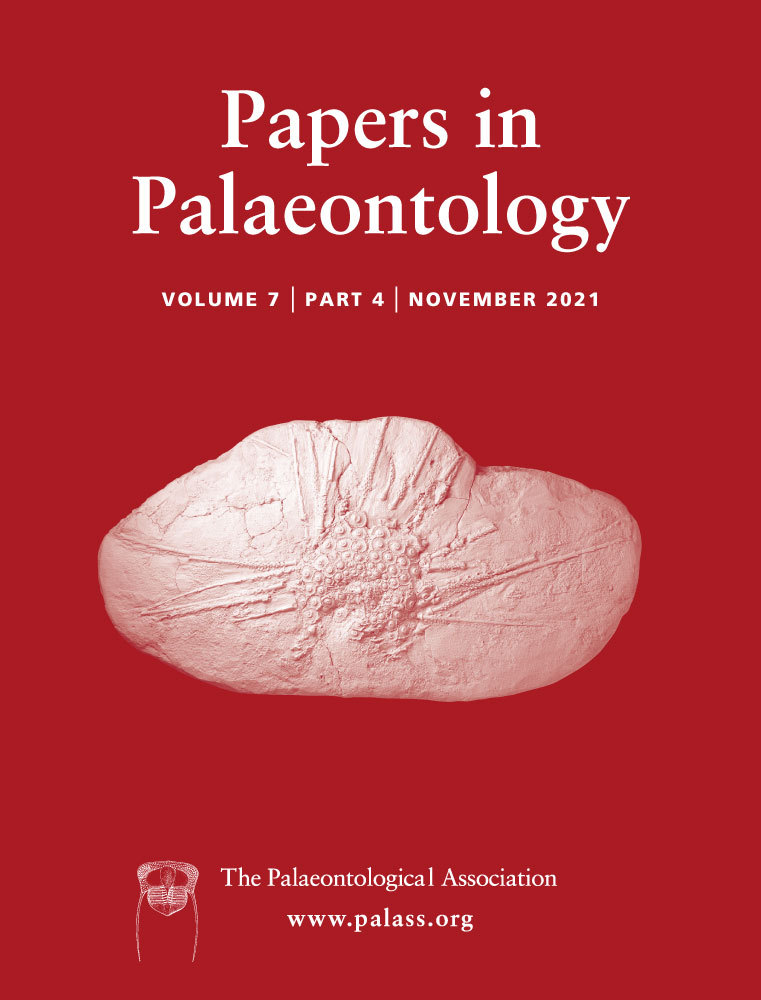A revision of Vernicomacanthus Miles with comments on the characters of stem-group chondrichthyans
Abstract
The ‘acanthodian’ fishes provide key anatomical insights into the deepest branches of the chondrichthyan stem group. We review the anatomy of the acanthodian Vernicomacanthus uncinatus from the Lochkovian (Lower Devonian, 419.2–410.8 Ma) of Scotland based on eight articulated fossils, one of which is newly described. Broadly, the anatomy of V. uncinatus fits with that of contemporaneous acanthodians such as Climatius and Parexus, with a head covered by robust tesserae, an enlarged postorbital scale, an armoured shoulder girdle, and many pairs of ventrolateral spines. However, it departs from this anatomy in key respects. Its pectoral fin spines are obliquely ridged and posteriorly denticulated, similarly to Carboniferous gyracanth stem-group chondrichthyans. Its scales consist of multiple anteroposteriorly aligned odontodes, similarly to many Palaeozoic ‘sharks’. And its endoskeletal shoulder girdle may have a posterolateral angle, previously observed only in shark-like chondrichthyans. We propose that the differences between V. uncinatus and its congeneric, V. waynensis, which include potentially phylogenetically significant characters of the shoulder girdle and spines, are sufficient to erect a new genus for V. waynensis: Dobunnacanthus gen. nov. The scales of Vernicomacanthus are identical to those of the ‘shark’ scale genus Altholepis, suggesting that some such scales may instead belong to taxa with acanthodian-like gross anatomies. Based on these scales we highlight potential patterns in chondrichthyan scale evolution, in particular the axial addition of odontodes. Anatomical similarities between Vernicomacanthus and gyracanths, highlighted by previous authors, may indicate the existence of a grade including these and similar acanthodian-grade taxa placed relatively crownwards in the chondrichthyan stem-group.
Over the last decade, evidence has mounted that ‘acanthodians’ (a collection of poorly understood fishes previously grouped with bony fishes, cartilaginous fishes, stem-gnathostomes, or all three) are in fact all stem-group chondrichthyans (Zhu et al. 95; Brazeau & Friedman 11; Coates et al. 29). These taxa have the potential to provide insight into the evolution of chondrichthyan morphology, as well as that of gnathostomes (jawed vertebrates) more broadly. However, a lack of traits widely comparable with outgroup taxa (i.e. endoskeletal data) conceals how acanthodians are related to one another as well as to ostensibly more shark-like stem-chondrichthyans, leading to poorly resolved phylogenetic relationships (Brazeau 9; Davis et al. 30; Zhu et al. 95; Giles et al. 43; King et al. 58; Chevrinais et al. 26; Coates et al. 29; Dearden et al. 33, Frey et al. 39). The best hope for broadly comparable phylogenetic characters, outside of rarely preserved endoskeletal structures, lies in the detailed microanatomy of acanthodians. However, few studies have been able to document these anatomical details in the context of articulated specimens.
This paper presents a new description and taxonomic re-assessment of Vernicomacanthus Miles, 65, an acanthodian from the Lower Devonian (Lochkovian, 419–411 Ma) Midland Valley of Scotland. Vernicomacanthus is known from rare articulated skeletons and provides valuable information on the morphological diversity of early acanthodians and other stem-group chondrichthyans (Miles 65). Miller (66) first described and figured remains that would later be assigned to Vernicomacanthus uncinatus (Powrie 78; Newman & Davidson 68), noting that the inner edge of a pectoral fin spine from Balruddery Den had ‘projecting prickles, that resemble sharp hooked teeth’ (Miller 66, p. 160). Later, the articulated type material was assigned to the species Climatius uncinatus by Powrie (76) based on a manuscript name by Egerton; Miles (65) subsequently found it sufficiently distinct from that taxon to erect a new genus. Miles (65) also assigned material from the Welsh borders to V. waynensis that we assign to a new genus in the present paper. This reassignment reflects anatomical differences in the shoulder girdle, spines, and size that distinguish the two taxa. Furthermore, assuming that these species are monophyletic in the absence of clear evidence could be problematic in the context of unsettled stem-chondrichthyan phylogenetic relationships.
Vernicomacanthus was assigned to the Climatiidae by Miles (65). The Family Climatiidae Berg, 1940, placed within the Order Climatiida Berg, 1940, are an assemblage of acanthodians with shoulder girdles carrying dermal plates, skulls clad in dermal tesserae, and pre-pectoral fin spines. The Climatiidae in particular have stout fin-spines with the dorsal and anal spines superficially inserted into the dermis, and evenly sized ornamental ridges that often bear nodes (Denison 34). The coherence of the Climatiida has decayed under phylogenetic interrogation. Beginning with Hanke & Wilson's (2004) ingroup analysis of acanthodians, climatiids were shown to be paraphyletic even under the assumption of acanthodian monophyly. In subsequent, more expansive analyses of early gnathostomes, the group decomposed into a poorly resolved paraphyletic array spanning some combination of the osteichthyan, chondrichthyan, and gnathostome stem-groups (Brazeau 9; Davis et al. 30; Zhu et al. 95; Giles et al. 43; Burrow et al. 22; King et al. 58; Chevrinais et al. 26; Coates et al. 29; Dearden et al. 33; Frey et al. 39). In more recent analyses they have been constrained to the chondrichthyan stem-group, alongside other acanthodian-grade taxa. However, their relationships to one another and to other total-group chondrichthyans remain poorly defined, with implications for the evolution of crown-group chondrichthyan characters (e.g. Maisey et al. 62).
The erosion of phylogenetic support for the climatiids has, at least in part, reflected the recent recognition of chondrichthyan-like traits in these taxa. Consequently, they have become a focal point in studies of chondrichthyan origins. The loss of support for their phylogenetic coherence has come from two sources. First, there is the recognition of chondrichthyan scale morphotypes in climatiids such as Kathemacanthus (Hanke & Wilson 50) and Parexus (Burrow et al. 20), or at least a lack of characteristically acanthodian superpositional scale growth (e.g. Brazeau 10; Burrow et al. 21; Chevrinais et al. 26). Second, there is the identification of climatiid-like hard tissue structures in the articulated skeleton of Doliodus (an undisputed chondrichthyan) showing stout, nodose, ribbed fin spines with shallow insertions, a complete complement of ventrolateral and prepectoral fin spines, and a differentiated head and trunk squamation (Miller et al. 67; Burrow et al. 23; Maisey et al. 62). It remains unclear to what extent the armoured and heavily spined climatiid conditions reflect shared derived traits of early crown-group chondrichthyans, or whether these are plesiomorphic traits of the chondrichthyan total group. Climatiid-like taxa variably appear in phylogenies as either nested close to crown-group chondrichthyans (Giles et al. 43; King et al. 58; Chevrinais et al. 26; Coates et al. 29; Dearden et al. 33), with remaining lightly armoured acanthodians in a more remote position, or as a basal grade of the chondrichthyan total group (Burrow et al. 22; Frey et al. 39), perhaps reflecting their retention of osteichthyan-like characters such as branchiostegal plates.
Here, we redescribe Vernicomacanthus on the basis of a new specimen as well as a re-examination of four specimens described previously. Despite having been known since the nineteenth century, Vernicomacanthus uncinatus has only been cursorily described (Powrie 76, 77; Miles 65). Moreover, modern acid preparation techniques have been demonstrated to be greatly effective on material from the Tillywhandland (also known as Turin Hill) locality in which all articulated V. uncinatus have been found, resulting in prepared fossils with highly informative external skeletons (Burrow et al. 20, 21, 24; Newman et al. 71). In many respects, V. uncinatus is like other climatiid-grade stem-group chondrichthyans, having tooth whorls, a Climatius-like head skeleton, and an armoured shoulder girdle (Miles 65). However, its fin spines have a number of similarities to the gyracanthids, a group of large-bodied Upper Devonian and Carboniferous stem-group chondrichthyans, and particularly to Ankylacanthus, a smaller, Lower Devonian putative gyracanthid (Burrow et al. 19). The cogeneric taxon, Vernicomacanthus waynensis, is broadly similar but has an unusual dermal pectoral girdle morphology (Miles 65). We erect a new genus, Dobunnacanthus gen. nov., for specimens previously assigned to V. waynensis.
Material and method
Material
The studied V. uncinatus material consists of six specimens from the National Museums of Scotland, Edinburgh (NMS), four specimens from the Natural History Museum, London (NHMUK), one specimen from the McManus Galleries and Museum, Dundee (DUNMG), and one specimen from the Montrose Museum (NH), Montrose. Together they comprise nine articulated fishes (two parts and counterparts are split between collections) and one disarticulated spine. All articulated material comes from Tillywhandland Quarry, near Forfar in Angus (Trewin & Davidson 83), which is assumed to be the source of the Old Red Sandstone ‘Turin Hill’ material. Tillywhandland is Lochkovian in age, and preserves an assemblage of osteostracan and acanthodian vertebrates, as well as plants and arthropods, from what is interpreted as having been a lake bed (Trewin & Davidson 83). Specimens from the fish bed of Tillywhandland are preserved in a characteristic four-layered laminite (Trewin & Davidson 83). Disarticulated spines of V. uncinatus have also been found in two other vertebrate-bearing sites in Angus of a similar age: Balruddery Den and Canterland Den.
Five V. waynensis specimens, and peels made from them, in the Natural History Museum, London were also examined. These are accessioned as NHMUK PV P 24938a,b, NHMUK PV P 16614, NHMUK PV P 16615 II, NHMUK PV P 52441a,b, and NHMUK PV P 52443.
Acid preparation
A new, previously undescribed specimen of V. uncinatus, NMS G.2001.7.4, was prepared out of the surrounding matrix using alternate washes of acetic acid, surfactant, and water. During this process the fossil itself was protected with paraloid B-72. Photographs of this specimen (in Figs 1 and 2A) were taken with an ammonium chloride coating. The residues from the preparation of this specimen were kept, and included several scales that had disarticulated from the body. Scanning electron microscopy (SEM) of the surface of this specimen were carried out at the Natural History Museum, London, using a Zeiss Ultra Plus field emission scanning electron microscope.
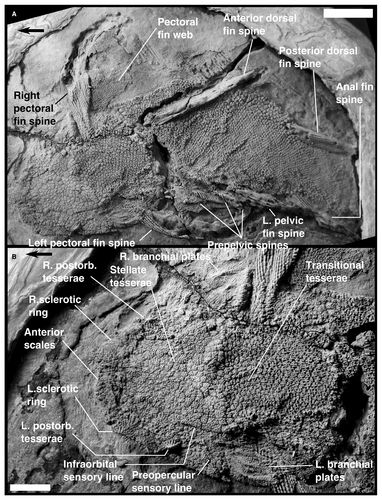
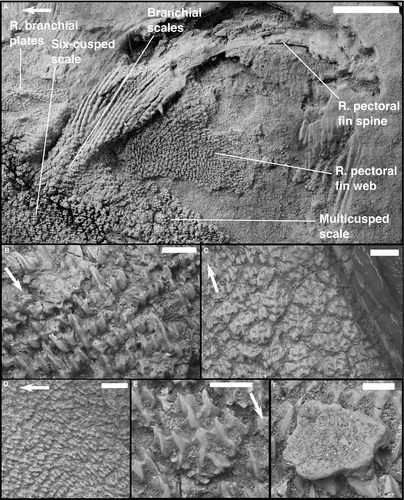
Computed microtomography
The most complete of the scales taken from the residues (NMS G.2001.7.4.1) was scanned using computed microtomography at the University of Bristol Life Sciences Department (Dearden 32). We used a Nikon XT H 225 ST, scanning at 90 kV and 78 μA. We achieved a voxel size of 2 μm. These data were segmented using Mimics v.19 (http://biomedical.materialise.com/mimics). Segmented models were then imported into Blender (https://www.blender.org) to acquire images.
Scale sections
Sections, between 40 and 50 µm thick, were made of three scales from the residues resulting from acid preparation of NMS G.2001.7.4 (NMS G.2001.7.4.1–3), including the scanned scale. These were prepared by embedding the specimens in Buehler EpoThin resin, cutting on Buehler IsoMet slow-speed saws, and imaged using plane-polarized light on a Zeiss Axioskop Pol polarizing microscope.
Spine sections
Sectioning was carried out on an isolated V. uncinatus pectoral fin spine from Balruddery Den (NMS G.2018.18.1). Nine sections were made, NMS G.2018.18.1.2–10, with the remnant designated NMS G.2018.18.1.1. These were made using epoxy resin and corundum grinding powder of various grain sizes down to 4 µm. Sections were ground down to between 30 and 60 µm, and were photographed using a Sony DSC-H2 camera on a Nikon Eclipse E 400 microscope.
Terminology
Odontodes are hypothetical units of dermal development, consisting of dentinous growth around a dermal papilla (Ørvig 73). For the purposes of our description we adopt a working definition of odontodes as dentinous tubercles each growing around their own central pulp cavity.
Institutional abbreviations
DUNMG, McManus Galleries and Museum, Dundee, UK; NH, Montrose Museum, Montrose, UK; NHMUK, Natural History Museum, London, UK; NMS, National Museums of Scotland, Edinburgh, UK.
Systematic palaeontology
Superclass GNATHOSTOMATA Gegenbaur, 42Class CHONDRICHTHYES Huxley, 53Genus VERNICOMACANTHUS Miles, 65
Type species
Vernicomacanthus uncinatus (Powrie) (= Climatius uncinatus Powrie, 76).
Type specimen
NMS G.1891.92.208 (Fig. 3) is the lectotype.
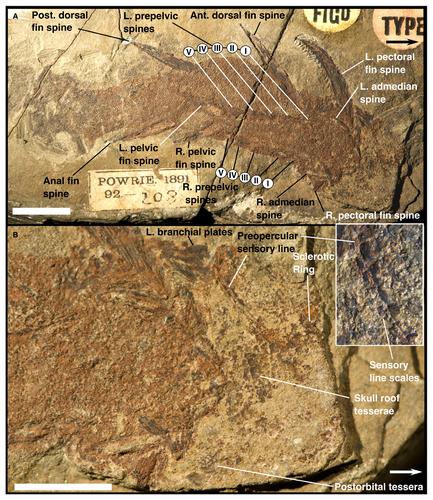
Remarks
Further to Miles’ description the following characters can be used to diagnose the genus Vernicomacanthus. Gnathostome symplesiomorphies: dorsoventrally closing jaws, teeth, sclerotic ring. Characters of uncertain polarity: branchial plates, dorsal fin spines, paired fin spines, tooth whorls. Shared with total-group chondrichthyans: dorsal scapular shaft, ventrolateral spines consisting of one pair of admedian and five pairs of prepelvic spines, microsquamose body integument, sensory lines pass between scales, skull roofed by polygonal tesserae. Shared with certain total-group chondrichthyans: anal fin spine, scales consisting of multiple laterally apposed odontodes, scales growing by posterior and lateral addition of elongate odontodes, ?posterolateral angle of scapulocoracoid. Shared with other climatiid acanthodians: dermal pectoral girdle integrating two paired prepectoral spines and a ventral pinnal plate, a median lorical spine-bearing plate, distinctly expanded postorbital tessera. Shared with some gyracanthids and some other stem-group chondrichthyans: fin spine ridges oblique to leading edge, row of denticles on trailing edges of pectoral fin spines.
Vernicomacanthus uncinatus (Powrie, 76)Figures 1–12
-
- 66
-
- ‘Balruddery spines’; Miller, p. 160, 1 fig.
-
- 76
-
- Climatius uncinatus Powrie ex Egerton MS, pp 422–423.
-
- 6
-
- Climatius Uncinatus; Anonymous, p. 7, 2 figs.
-
- 77
-
- Climatius uncinatus; Powrie, p. 296, pl. 14 fig. 11.
-
- 7
-
- C. uncinatus Eg.; Barkas, p. 549.
-
- 78
-
- Climatius Uncinatus; Powrie, p. 168.
-
- 93
-
- Climatius uncinatus J. Powrie (ex Egerton, MS); Woodward & Sherborn, p. 37.
-
- 92
-
- Climatius uncinatus Powrie; Woodward, p. 30.
-
- 82
-
- Climatius uncinatus Powrie; Traquair, p. 3.
-
- 31
-
- Climatius uncinatus; Dean, pp 216, 222, fig. 24.
-
- 52
-
- Climatius uncinatus Pow.; Hickling, table.
-
- 65
-
- Vernicomacanthus uncinatus; Miles, p. 140, pl. 7 fig. 33.
-
- 75
-
- Vernicomacanthus uncinatus (Powrie ex Egerton MS); Paton, p. 5.
-
- 34
-
- Vernicomacanthus uncinatus (Powrie); Denison, p. 30, fig. 14F.
-
- 37
-
- Vernicomacanthus uncinatus (Powrie); Dineley, pp 150, 154.
-
- 13
-
- Vernicomacanthus uncinatus (Powrie); Burrow, p. 827.
-
- 19
-
- Vernicomacanthus uncinatus (Powrie); Burrow et al., p. 907.
-
- 68
-
- Vernicomacanthus uncinatus (Powrie ex Egerton MS); Newman & Davidson, pp 22–24, figs 28–30.
-
- 70
-
- ‘Climatius’ uncinatus Powrie; Newman et al., p. 758.
-
- 21
-
- C. uncinatus; Burrow et al., p. 3.
-
- 54
-
- Vernicomacanthus uncinatus; Jerve et al., p. 21.
-
- 62
-
- Vernicomacanthus uncinatus; Maisey et al., pp 11, 13, fig. 7B.
-
- 72
-
- Vernicomacanthus uncinatus (Powrie ex Egerton MS); Newman et al., pp 448, 450, 453, table 1.
-
- 24
-
- Vernicomacanthus uncinatus (Powrie ex Egerton MS); Burrow et al., p. 357.
-
- 63
-
- Vernicomacanthus uncinatus; Maisey et al., fig. 5.2E.
Material
NHMUK PV P 1342a, NHMUK PV P 6960, NHMUK PV P 1342, NMS G.1891.92.208 (lectotype), NHMUK PV P 6968, NMS G.2001.7.4, counterparts NMS G.1891.92.209 and DUNMG Kinnaird 82, counterparts NMS G.1891.92.210 and NH Mitchell 57, NMS G.1885.54.69, NMS G.2018.18.1.
Occurrence
Fossils of V. uncinatus are known from Tillywhandland (‘Turin Hill’) and Canterland Den (NHMUK PV P 6967, a pectoral fin spine) near Forfar, and Balruddery Den, near Dundee, all in Angus, UK. The horizon from which the fossils come is the Arbuthnott–Garvock Group, Dundee Flagstone Formation, Lower Old Red Sandstone
Emended diagnosis
As for genus
Description
General features
All complete specimens of V. uncinatus are between c. 70 and 85 mm in length (Figs 1, 3-6). The lengths of most incomplete specimens are consistent with this, although specimen NHMUK PV P 1342a is 80 mm long and everything posterior to its pelvic fin spines is not preserved (Fig. 4), suggesting that some animals may have reached lengths of up to 100 mm. Miles (65) reported a length of 150 mm for V. uncinatus; this is presumably a typographical error given that he later states that V. waynensis is of ‘greater size’ and ‘at least 140 mm’ in length. In overall shape V. uncinatus is similar to Climatius, with an elongate body, and a heterocercal tail with a pronounced hypochordal lobe. The pectoral fins are proportionately larger than those of Climatius or Parexus (compare Fig. 3A to Burrow et al. 20, fig. 6a, 21, fig. 1c). A reconstruction is shown in Figure 7A, B.
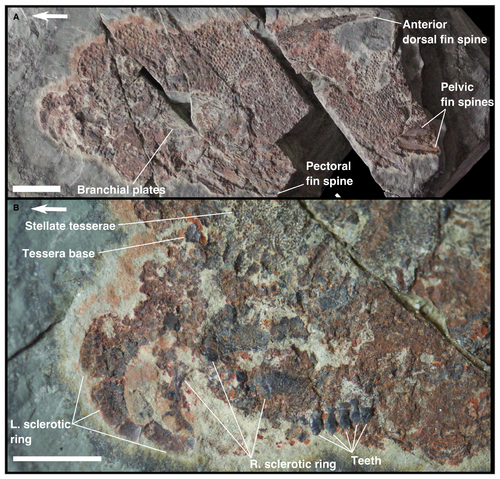

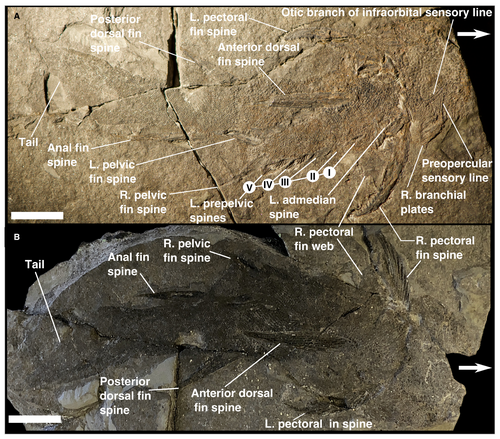
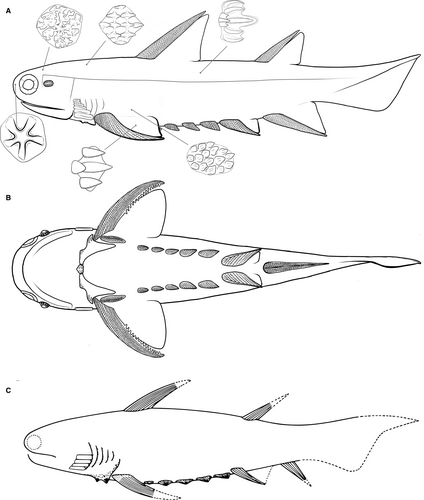
Head skeleton
The external head skeleton of V. uncinatus is especially well-preserved in two articulated specimens: NMS G.2001.7.4 (Fig. 1A) and DUNMG Kinnaird 82 (Fig. 5C, and see Miles 65 for specimen prior to over-preparation). The account given here is mainly based on these two, as well as on details from NMS G.1891.92.208 and NHMUK PV P 1342a (Figs 3B, 4B). In DUNMG Kinnaird 82, NMS G.2001.7.4 and NMS G.1891.92.203, the head is dorsoventrally flattened. The head's proportions are similar to those of other climatiid-grade animals such as Climatius and Parexus (Burrow et al. 20, 21). The orbits have a strongly anterior position (e.g. Figs 4B, 5C) as in numerous other stem-chondrichthyans, for example diplacanthids (Burrow et al. 22), ischnacanthids (Blais et al. 8), acanthodids (Heidtke 51), Climatius (Burrow et al. 21), Parexus (Burrow et al. 20) and Brochoadmones (Hanke & Wilson 49). Teeth are present and visible in DUNMG Kinnaird 82 and NHMUK PV P 1342a (Figs 4B, 5C), and these appear to be arranged in lateral families of tooth whorls as in other climatiid-grade fishes (e.g. Ptomacanthus; Miles 65), but there is no clear view of the cusps, and their distribution around the jaws is undeterminable.
The skull roof in V. uncinatus is covered with tessellating tesserae (Figs 1B, 3B, 4B, 5C, 8A, B), similar to those of other climatiid acanthodians such as Climatius and Parexus (Burrow et al. 20, 21). These are irregular in shape and pattern, but most plates have one larger, roughly central stellate tubercle, surrounded by radiating rows of smaller unornamented tubercles (Fig. 8B). These tesserae cover the roof of the skull between the level of the shoulder girdle and the snout (Fig. 1B). Towards the snout, the tesserae become larger and more densely packed with tubercles. Some of these anterior tesserae have a more specialized shape, and could be something more like the circumnasal plates of Climatius (Miles 65) than tesserae, although it is difficult to make out exact borders of elements. The extreme anterior end of the snout is covered in very small stellate scales (Figs 1B, 8E), similar to those described in Obtusacanthus (Hanke & Wilson 48, fig. 6).
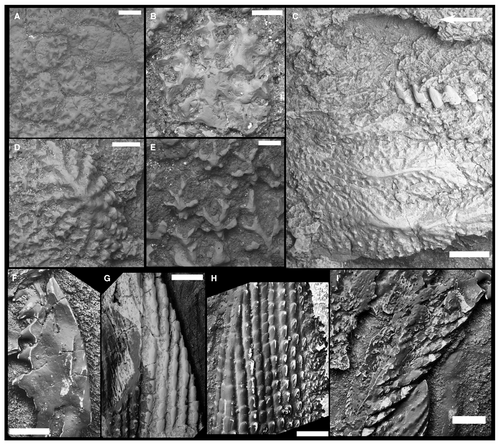
The position of the anteriorly placed orbits are marked by sclerotic rings (Figs 1B, 4B, 5C). The dorsalmost two plates forming the ring on both sides of the head are visible on NMS G.2001.7.4 (Fig. 1B). Both sclerotic rings are visible in NHMUK PV P 1342a (Fig. 4B); individual plates are difficult to count exactly but from their size and shape seem likely to number five as in Parexus and Climatius (Burrow et al. 20, 21). Each bone is slightly convex and ornamented with tuberculate ridges radiating outwards from the edge facing into the orbit. Posteriorly to each orbit is a large, spine-like postorbital tessera. These have a pronounced peak and are ornamented with tuberculate ridges radiating outwards from the apex (Figs 1B, 8D). Between these postorbital tesserae and the branchial plates, tesserae are slightly smaller, although still tuberculate. Although no pattern can be discerned, markedly larger tesserae appear to be present on either side anterior to the lowermost visible branchial plate.
The dermal covering of the branchial region is best visible on the left-hand side of NMS G.2001.7.4 (Figs 1B, 2A, 8C), and consists of a dermally plated hyoid operculum and smaller scales. The hyoid operculum has a similar structure to that in Climatius (Burrow et al. 21), being formed by a number of broad branchiostegal plates (Figs 1B, 8C). The most ventral visible plate is the largest and is ornamented with a large anterodorsal ridge extending along the middle two-thirds of its length. Smaller ridges extend dorsally and ventrally from this ridge. Around these ridges, particularly anteriorly, the plate is ornamented with small tubercles. The whole plate, including the main ridge, has a slight curve, giving it a convex ventral side. Other plates are similar in overall shape, but decrease in size dorsally. This makes their exact number difficult to count, but in NMS G.2001.7.4 there are at least five, and possibly as many as seven. The branchial integument posterodorsal to the plates is difficult to observe, but is made up of small scales. These are best visible in NMS G.2001.7.4, in which small scales with anteroposteriorly aligned ridges lie posterodorsally to the branchiostegal plates (Fig. 2A). These may be equivalent to the small scales fringing the gill openings in Climatius (Watson 89). However, no rod-like fringing scales, such as those in Climatius (Burrow et al. 21), Euthacanthus (Newman et al. 69, 71) and Brachyacanthus (Watson 89), are visible.
The sensory lines are particularly clearly visible in specimens DUNMG Kinnaird 82 and NMS G.1891.92.208 (Figs 3B, 5C), and are broadly similar to those of other stem-group chondrichthyans. The otic branches of the infraorbital sensory line are the most clearly visible, particularly so in DUNMG Kinnaird 82, which shows that they curve laterally as they pass posteriorly to join the lateral lines, together forming a lyre shape in dorsal view (Fig. 5C). On this specimen Miles (65) also identified preopercular canals; these are visible anterior to the branchial plates in DUNMG Kinnaird 82 and NMS G.2001.7.4, where they curve anteriorly to meet the otic branches of the infraorbital sensory line (Fig. 5C). This canal is also clearly visible on NMS G.1891.92.208 (Fig. 3). Also visible on DUNMG Kinnaird 82, but not figured by Miles, is the postorbital sensory line (Fig. 5C).
The sensory lines of the head are edged by rectangular scales, best seen in the infraorbital canal of DUNMG Kinnaird 82 (Fig. 5C; Miles 65, pl. 7) and the preopercular canal of NMS G.1891.92.208 (Fig. 3B). These scales are smaller than the tesserae of the skull roof, and each is offset from its opposite number along the course of the sensory line. This offset suggests that the sensory line passed between paired scales, rather than being carried in c-shaped scales as in Acanthodes (Zidek 96). In NMS G.2001.7.4 the sensory line is almost invisible (also see DUNMG Kinnaird 82 in Miles 65, pl. 7), whereas in the more heavily worn NMS G.1891.92.208 a clear space is present (Fig. 3B). This suggests that the crowns of the scales arched over the sensory line to some extent, as in Cheiracanthus (Burrow et al. 25) and Ischnacanthus (Burrow et al. 24).
Shoulder girdle
The ventral dermal pectoral girdle has been described in detail by Miles (65). Our specimen observations largely confirm his account that the dermal shoulder girdle consists of paired pinnal plates each with two prepectoral spines, and a median prepectoral spine (Fig. 9). A new observation is that the squamation dorsal to the pectoral fin spines is formed from small tesserae with smooth rounded crowns. These are visible in NMS G.2001.7.4, and a patch is clearly visible immediately dorsal to the right pectoral fin spine in NMS G.1885.54.69 (Fig. 10C), showing that in life it would have overlain the lateral face of the scapulocoracoid.
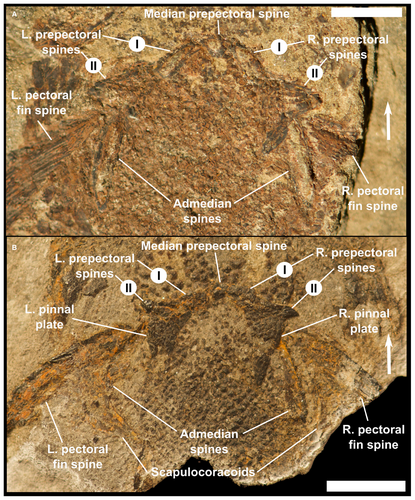
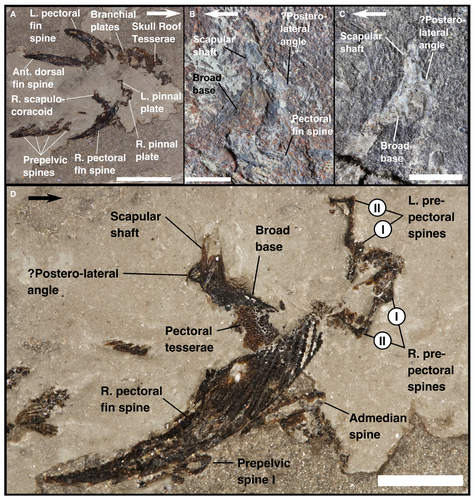
The scapulocoracoid is best preserved in NMS G.1885.54.69, split between the part and counterpart (Fig. 10A, D). The fish has been dorsoventrally flattened, and the scapulocoracoid is split down the middle, with the inside of the medial face preserved in one part, NMS G.1885.54.69a, and the scapulocoracoid in medial view with the medial face removed in the other, NMS G.1885.54.69b. Miles (65) described the scapulocoracoid of Vernicomacanthus as perichondrally ossified. We have no additional data to confirm this, but the surface of the element is uniform, lacks tesserae, and lacks the granular texture of endoskeletal tissues interpreted as mineralized cartilage in some other acanthodians (Hanke & Wilson 50), consistent with it being perichondral bone (Fig. 10D). This would be in keeping with sectioned acanthodian scapulocoracoids, which are formed from laminar bone (e.g. Burrow et al. 21, 22, 24). However, we note that some stem-chondrichthyans have endoskeletal structures that outwardly could be perichondral but are in fact cartilaginous, for example the jaws of Ischnacanthus (Burrow et al. 24) and the visceral skeleton of Diplacanthus NMS G.1891.92.334 (Brazeau et al. 12).
The scapulocoracoid is L-shaped, with a pronounced dorsal scapular shaft, and is laterally flattened (Fig. 10). The scapular shaft is slender with anterior and posterior margins that taper towards a rounded-off dorsal tip. It meets the ventral part of the scapulocoracoid at a 135° angle around the frontal axis. This ventral section is triangular and tapers to an anterior point where it meets the anterior margin of the fin spine insertion. The ventral margin of the scapulocoracoid is flat, rising posteriorly to meet the scapular shaft. On the posterior edge of the scapular shaft is a pronounced process, clearly visible in NMS G.1885.54.69 (Fig. 10D), which can also faintly be seen in NHMUK PV P 1342a (Fig. 10B) and NHMUK PV P 1342 (Fig. 10C). This bears a similarity to the posterolateral angle observed in many conventional chondrichthyans (Coates & Gess 27), although its position on the scapular shaft is low by comparison. Another possible identity is a fin articulation as in Gogoselachus (Long et al. 60). However, the location of the process in NMS G.1885.54.69 is dorsal to the level of the fin spine insertion. This is topologically out of place for a pectoral glenoid, which is normally situated within the sulcus of the spine itself (Miles 65; Maisey et al. 62). Further preparation of NMS G.1885.54.69 will be carried out to better resolve its morphology.
Spines
The pectoral fin spines are about one-quarter of the length of the body, measured in a straight line from base to tip, have a broad base, and curve posteriorly (Figs 1, 3, 5, 6). They are ornamented with ridges formed of flat, overlapping nodes (Fig. 8G), oriented obliquely towards the leading edge of the fin spine. This ornament occurs uniformly along the length of the spine. Posteriorly the fin spine is ornamented with large, pointed denticles (Figs 3A, 8F). They are slightly curved inwardly, pointing towards the insertion of the fin spine. These posterior denticles occur along the entire length of the fin spine's trailing edge, from tip to insertion. Burrow et al. (19) reported a double row of trailing edge denticles, interpreting the pectoral fin spine of NHMUK PV P 6960 as preserving one row along the spine's distal tip and another in the impression of its middle part. Based on observations of this and other material we interpret there to be only a single row, with NHMUK PV P 6960 preserving a dorsal and ventral view of this same row. The pelvic fin spines are slightly curved, and ornamented with oblique rows of denticles, but are shorter than the pectoral fin spines, about one-tenth of total body length, and lack posterior denticles.
Two dorsal fin spines are present; these are longer relative to body length than those of Climatius and Brachyacanthus and are slightly curved and laterally flattened (Figs 1, 3-6). The anterior dorsal fin spine is about one-quarter of total body length, slightly longer than the posterior, which is about one-fifth of total body length. They are ornamented with oblique rows of rounded nodes borne on ridges, converging on the leading edge of the spine (Fig. 8H), and no trailing-edge denticles are present. The anal fin spine is also ornamented with noded ridges, slightly curved, and is about one-quarter of the total body length.
Vernicomacanthus uncinatus has six pairs of ventrolateral spines: five pairs of prepelvic and one pair of admedian spines. These are countable in all three examples positioned with an extended abdomen: NMS G.1891.92.208 (Fig. 3), DUNMG Kinnaird 82 and NMS G.1891.92.209 (Fig. 5), and NH Mitchell 57 and NMS G.1891.92.210 (Fig. 6). In other specimens it is difficult to perform a full count due to missing pieces of matrix or the specimen's position. The admedian spine is located ventral to the shoulder girdle, between the pinnal plate and the insertion of the pectoral fin spine (Fig. 9). The prepelvic spines series continue posteriorly, in line with the admedian spine, with the posteriormost prepelvic spine situated close to the pelvic girdle, but displaced slightly laterally relative to the pelvic fin spines. More posterior prepelvic spines become progressively larger. In NMS G.2001.7.4 the ventrolateral spines were pushed together during preservation, making it difficult to perform a count (Fig. 1A). However, this specimen shows the best view of the individual spines themselves. The spines are short, elliptical in cross-section, and the inserting end is open (Fig. 8I). They are ornamented with oblique rows of small nodes, as with the other spines. Proximally these nodes are smaller and more pointed than those on the fin spines; distally they become more rounded, and more organized into ridges.
The histological structure of the sectioned pectoral fin spine NMS G.2018.18.1 is similar to that of other climatiid acanthodian fin spines such as Climatius and Parexus (Burrow et al. 20, 21) (Fig. 11). The pulp cavity is large, becoming relatively smaller towards the distal end of the spine (Fig. 11A). The outside of the cavity is bordered by a thin layer of lamellar tissue; this is so thin as to be invisible in some sections, and is possibly present only intermittently, but can be best seen in section 5 (Fig. 11C). Outside this lamellar layer is a thick layer of osteodentine (trabecular dentine), punctured by large, presumably vascular, canals (Fig. 11C, D). No osteons are visible. The spine becomes progressively more compact as the canals diminish in size towards the tip (Fig. 11A, F), and vascular canals towards the surface of the spine are smaller in diameter, with some present inside the ornament ridges (Fig. 11C). The surface of the ornament is formed from a dentine with branching tubules extending outwards from the vascular canals and intersecting with cell spaces (Fig. 11C, E), identical to tissue identified as mesodentine in other fin spines such as those of Parexus (Burrow et al. 20). Enameloid is absent. Osteocyte lacunae are present throughout the tissues, including in the lamellar layer (Fig. 11D, F).
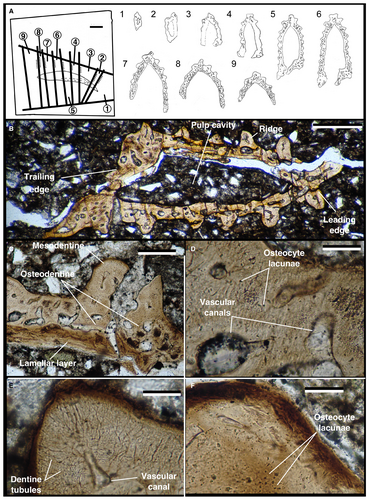
Body squamation
The body scales are organized into diagonal lines, and become gradually smaller posteriorly on the body (Fig. 1A). Scale crowns consists of several elongate, anteroposteriorly oriented cusps, with a large central cusp flanked by two pairs of smaller cusps on the majority of scales (Figs 2B, 12). Most body scale crowns have this symmetrical organization, with five parallel cusps. However in some areas of the squamation, such as in an area immediately anterior to the first dorsal fin and on parts of the flank, scales are asymmetrical with six parallel cusps (Fig. 2A). These are organized as in symmetrical scales, but with three, rather than two, smaller cusps on the side of the crown facing the fish's ventral side. Below the anterior dorsal fin spine is a region of scales that are more tessera-like, with horizontal ridges connecting the longitudinal cusps (Fig. 2C). A similar condition was described in the midline of Dobunnacanthus waynensis gen. nov. (Miles 65). The right pectoral fin of NMS G. 2001.7.4 also preserves scales; these are much like the body scales in all aspects except that they are smaller and possess only three or four cusps (Fig. 2A, D). In an area at or above the fin insertion are large scales with numerous short, unaligned cusps (Fig. 2A, ‘multicusped scale’). These appear superficially similar to the artichoke-shaped scales in the shoulder girdle of Kathemacanthus (Hanke & Wilson 50), isolated scales found in association with Parexus (Burrow et al. 20, fig. 11M), and the pinnal plate of Parexus and Sevyacanthus (Burrow 13; Burrow et al. 20). The arrangement of cusps in these scales is also similar to that in gyracanthid scales (e.g. Owen 74, ‘Mitrodus quadricornis’; Snyder et al. 81, ‘Gyracanthus’ sherwoodi), although the cusps are much shorter.
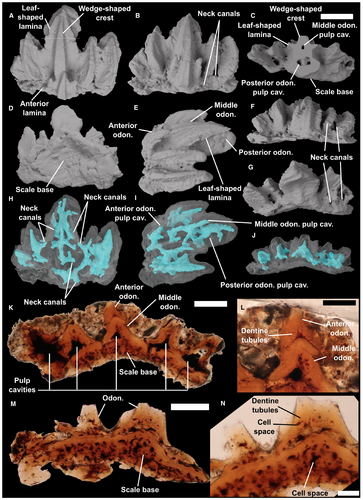
The transition between the head tesserae and the body scales is gradual rather than an abrupt boundary. At the rear of the skull roof the tubercles ornamenting the tesserae become progressively more anteroposteriorly oriented (Figs 1B, 2E) in more posteriorly located tesserae, but remain joined by ridglets perpendicular to the cusps. These ridglets are gradually lost in more posterior tesserae, giving way to the anteroposteriorly oriented cusps of the body squamation. A similar condition was reported in D. waynensis gen. nov. (Miles 65).
The body scales of V. uncinatus consists of a polyodontode crown on a thin, concave base (Fig. 12). This base is polygonal, and wider than it is long (Fig. 12A, D), with a slight anterior lamina beyond the anterior margin of the crown, resembling an overlap surface (Fig. 12A). The crowns of the body scales of V. uncinatus are formed from multiple anteroposteriorly elongate odontodes. Each odontode except for the posteriormost one (see below) corresponds to a single scale cusp, consisting of an underlying leaf-shaped lateral lamina topped by a sharply defined, wedge-shaped crest that tapers posteriorly. Although the base of each odontode is firmly attached to the scale base, they extend posteriorly well past the scale base and in articulation the crown overlies the anterior laminae of the bases of the posterior two scales (Figs 1A, 2B, 12). The large middle odontode is linked to its lateral counterparts by the fusion of their lateral laminae (Fig. 12B, E). Anteriorly to the large odontode, on the central axis of the scale, is a smaller odontode (Fig. 12A–C, E). Like its larger fellows it has a pronounced dorsal ridge, but its underlying lamina is shaped into two posterior points flanking the dorsal ridge. Underlying the largest odontode is an additional odontode of similar size to it (Fig. 12E). The crest of this basal odontode is obscured by the growth of the overlying central odontode, but its lamina can be seen projecting laterally. Cell spaces visible in section show that the scale base is made from cellular bone (Fig. 12K, M, N) like that in other stem-chondrichthyans such as Gladbachus (Burrow & Turner 17, fig. 2). The crown of the scale is formed from a dentinous tissue with branching tubules intersecting with cell spaces (Fig. 12L, N), as in tissues identified as mesodentine in other stem-chondrichthyan scales such as Diplacanthus (Burrow et al. 22, fig. 21).
Internally each odontode has a separate pulp cavity (Fig. 12H, I). This cavity comprises an anteroposteriorly elongate void that runs most of the length of the odontode (Fig. 12H–J). The pulp cavity is restricted to the centre of the odontode, and does not extend into the dorsal ridge, although this is likely to vary with the scale's age (Fig. 12J). The pulp cavities of the two lateralmost odontodes are far broader than those in the more medial odontodes, filling almost the entire odontode (Fig. 12H), probably a result of their relatively younger age. Branching off the pulp cavity laterally are several neck canals of similar lumen size to the pulp cavity, which extend ventrolaterally out of the odontode (Fig. 12H–J). These canals are inconsistent in number in individual odontodes, but each odontode has at least two pairs of neck canals. Because of the growth of the scale some of these neck canals end in dead ends within the crown, although many remain open on the surface of the scales (Fig. 12F, G). Most are visible on the posterior neck of the scale, fewer open between odontodes or anteriorly. Although the pulp cavities are separate, some of them communicate within the scale via neck canals; this can particularly be seen between the central large odontode and the large odontode underlying it (Fig. 12H–J). Canals penetrating the base are absent in the scanned specimen, and canal openings appear to be absent on exposed bases of scales on the surface of specimen NMS G.2001.7.4 (Fig. 2F).
The configuration of the odontodes in Vernicomacanthus is identical to that of Altholepis (Fig. 11) (Karatajūtė-Talimaa 56). Karatajūtė-Talimaa interpreted scale growth in Altholepis as involving the addition of odontodes ‘laterally and behind the primordial [odontode]’. In Vernicomacanthus the equivalent to the primordial odontode in Karatajūtė-Talimaa's Altholepis description is the central odontode, and the posterior odontode's morphology is consistent with having been added after it. The lateral odontodes were added laterally in symmetry around the central odontode, with the relatively large size of the pulp cavities in the lateralmost two odontodes probably reflecting their relatively young age. However, the Altholepis specimens upon which Karatajūtė-Talimaa's account was based lacked a small anterior odontode present in Vernicomacanthus (and Altholepis salopensis Burrow & Turner, 18). This was probably added to the scale after the large central odontode, given that it overhangs it considerably, which is even more pronounced in some isolated Altholepis scales (e.g. Burrow & Turner 18, fig. 1a, b).
Genus DOBUNNACANTHUS nov.
LSID
urn:lsid:zoobank.org:act:A3668266-52A8-4B79-896D-BD560AAC03AF
Derivation of name
After the Dobunni, a tribe of ancient Britons whose territory extended into Southern Herefordshire (Allen 1; Van Arsdell 87), and akantha, Greek for ‘thorn’.
Holotype specimen
NHMUK PV P 24938a,b
Type species
Dobunnacanthus waynensis gen. nov. (= Vernicomacanthus waynensis Miles, 65).
Diagnosis
Further to Miles’ description these characters can be used to diagnose the genus Dobunnacanthus. gen. nov. Autapomorphies: ascending pinnal lamina over half as high as scapulocoracoid. Gnathostome symplesiomorphies: dorsoventrally closing jaws, teeth, sclerotic ring, ventral lateral line on flank. Characters of uncertain polarity: branchial plates, dorsal fin spines, paired fin spines, tooth whorls. Shared with total-group chondrichthyans: dorsal scapular shaft, anal fin spine, ventrolateral spines consisting of one pair of admedian and five pairs of prepelvic spines, microsquamose body integument, sensory lines pass between scales. Shared with other climatiid acanthodians: dermal pectoral girdle with two prepectoral spines and a median spine, dermal head skeleton formed from interlocking tesserae, scales with multiple laterally apposed odontodes. Shared with gyracanthids and some other stem-group chondrichthyans: fin spine ornament oblique to leading edge. Differs from Vernicomacanthus in that it is larger in size (at least 140 mm in length), the dermal shoulder girdle lacks a pinnal plate, the anterior lorical plate does not contact the dermal complex carrying the prepectoral spines, the scapular shaft of the scapulocoracoid lacks a posterolateral angle, and pectoral spines are not posteriorly denticulated.
Remarks
Miles (65) erected the genus Vernicomacanthus on the basis of a collection of traits, none of which is obviously autapomorphic. Beyond general observations on proportions he highlighted that the genus shared an ‘anterior dorsal fin spine slightly curved and longer than pectoral fin spine, but not as elongated as in Parexus; dermal shoulder-girdle reduced to anterior lorical, and ascending pinnal lamina of a compound pinnal plate, and with at least one paired prepectoral spine’. We judge it unclear that the anterior dorsal spine is longer than the pectoral in Dobunnacanthus waynensis gen. nov. (Fig. 13; Miles 65), and in any case it is also present outside the proposed genus across an anatomically disparate range of stem-group chondrichthyans, for example Euthacanthus, Diplacanthus and Brochoadmones (Hanke & Wilson 49; Newman et al. 71; Burrow et al. 22). Regarding the dermal shoulder girdle there is no evidence for an ascending pinnal lamina in Vernicomacanthus uncinatus, while Dobunnacanthus waynensis gen. nov. lacks a ventral pinnal plate. A similar anterior lorical is also present in Parexus (Miles 65), while having at least one paired prepectoral spine is very common in a broad array of stem chondrichthyans (e.g. Promesacanthus, Climatius, Doliodus, Euthacanthus; Miles 65; Hanke 45; Burrow et al. 21; Maisey et al. 62). Because of this we consider there to be a lack of evidence that the genus is monophyletic and so we are erecting a new genus.
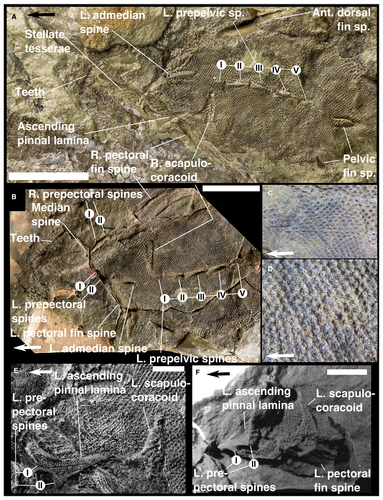
Dobunnacanthus waynensis (Miles, 65)Figure 13
-
- 65
-
- Vernicomacanthus waynensis Miles, p.140, pls. 1, 8–10, figs 1, 3.
-
- 34
-
- Vernicomacanthus waynensis Miles; Denison, p. 30, fig. 15F.
-
- 84
-
- Vernicomacanthus waynensis; Turner, p. 885.
-
- 38
-
- Vernicomacanthus waynensis Miles; Dineley, pp 113, 133, 135, fig. 4.18B.
-
- 49
-
- Vernicomacanthus waynensis; Hanke & Wilson, pp 534–535.
-
- 16
-
- Vernicomacanthus waynensis Miles; Burrow & Turner, p. 136.
-
- 72
-
- Vernicomacanthus uncinatus (Powrie ex Egerton MS); Newman et al., pp 450, 453, table 1.
Material
NHMUK PV P 24938a,b [holotype]; NHMUK PV P 16614; NHMUK PV P 16615 II; NHMUK PV P 52441a,b; NHMUK PV P 52443.
Diagnosis
As for genus.
Remarks
Unlike Vernicomacanthus, Miles (65) described Dobunnacanthus gen. nov. in detail based on peels made from a series of moulds from Wayne Herbert Quarry. No new material has been described since then, but we have some observations to add as a result of the comparison of this material to Vernicomacanthus. Miles’ reconstruction is shown in Figure 7C.
Occurrence
All specimens are from Wayne Herbert Quarry, Herefordshire, UK (White 90; Allen & Tarlo 2).
Description
Squamation
The tesserae of the head are similar to those in other climatiids: roughly hexagonal in shape and tuberculated (Fig. 13A). As Miles (65) observed, the flank scales of Dobunnacanthus gen. nov. are ornamented with anteroposteriorly aligned ridges (Fig. 13C, D). These appear to be very similar to the scales of Vernicomacanthus, with their laterally apposed odontodes. However, because the internal structure of the scales is not preserved, it is impossible to definitively diagnose this.
Shoulder girdle
Dobunnacanthus gen. nov. has an unusual morphology of the dermal shoulder girdle, noted by Miles (65). The description by Miles appears to be accurate; the two prepectoral spines in life would have been in the same anatomical position as those in other stem-group chondrichthyans, on the coracoid part of the shoulder girdle.
The moulds of the scapulocoracoid appear to lack a posterolateral angle, unlike Vernicomacanthus (Fig. 13E, F).
Spines
The pectoral fin spines of Dobunnacanthus gen. nov. are as described by Miles (65). Miles implies that the ornamentation of the pectoral fin spine converges obliquely on the leading edge of the spine and that they lack trailing-edge denticles; we confirm that this is the case (Fig. 13B, right pectoral spine). Miles also noted that the pectoral fin spines’ ‘beaded ridges’ dissolve into tubercles proximally. We note that this is also the case in Climatius (Burrow et al. 21, fig. 2c), but not in Vernicomacanthus (Fig. 1), Ankylacanthus (Burrow et al. 19) or Parexus (although clear views of this part of the ornament are rare) (Burrow et al. 20).
Discussion
Stem-group chondrichthyan scales
The scales of Vernicomacanthus highlight the dissonance between microfossil-based and body fossil-based taxonomies for chondrichthyan-like vertebrates. The scales of Vernicomacanthus are identical to scales attributed to the microfossil taxon Altholepis Karatajūtė-Talimaa, 56. Moreover, an articulated fish unofficially assigned to Altholepis from the Man On The Hill (MOTH) locality bears markedly similar fin spines to Vernicomacanthus, with nodulate ridges converging on the leading edge (G. Hanke, pers. comm. 2020). Altholepis has been consistently classed as a chondrichthyan in papers describing Lower Devonian microfossil assemblages from across Euramerica (Karatajūtė-Talimaa 56; Martinez-Perez et al. 64; Turner et al. 86; Burrow & Turner 18). Were the scales of Vernicomacanthus to have been found in isolation, they would have been described as chondrichthyan and very likely assigned to the genus Altholepis. Given the inconsistency between body fossil and microfossil taxonomies, distinguishing acanthodians from chondrichthyans is misleading, particularly for palaeoecological and phylogenetic calibration studies that frequently rely on these higher level taxonomies. Alternatively, a clearer taxonomy may be achieved by restricting Acanthodii to the putative clade consisting of Acanthodiformes, Diplacanthidae, and Ischnacanthiformes, ranked within the Chondrichthyes (Coates et al. 29), a topology that has found support in some recent analyses (e.g. Giles et al. 43, Coates et al. 29, Dearden et al. 33, Frey et al. 39).
Polyodontode scales similar to those of Vernicomacanthus (and Altholepis) have been observed in body fossils of a morphologically diverse range of Palaeozoic chondrichthyans. These scales grew by the areal addition of multiple odontodes to the scale base and fit with the ‘ctenacanthid’ chondrichthyan morphological type (Reif 80). Similar scales are present in several Palaeozoic chondrichthyan taxa that possess traits associated with the chondrichthyan crown-group (such as tessellated calcified cartilage and tooth whorls with separated bases), including Antarctilamna, Diplodoselache, Gogoselachus and Tamiobatis (Dick 36; Young 94; Williams 91; Long et al. 60). However, they are also present in a number of stem-group chondrichthyan taxa with acanthodian-like traits, including Ankylacanthus, Doliodus, Gyracanthides, Vernicomacanthus and possibly Dobunnacanthus (Miles 65; Warren et al. 88; Miller et al. 67; Turner et al. 85; Burrow et al. 19). If homologous, these polydontode scales may constitute evidence of a close relationship between these stem-group chondrichthyans and the chondrichthyan crown-group, or of these animals’ comprising a sister-group assemblage to an acanthodian clade. Intriguingly, some of the shark-like taxa with these scales share other aspects of the dermal squamation in common with acanthodians; Tamiobatis and Gogoselachus are both associated with dermal structures that look remarkably like the stellate head tesserae and sensory-line scales of acanthodians (Williams 91; Long et al. 60), particularly those assigned to Nostolepis striata (Gross 44). In Diplodoselache the body squamation is organized along diagonal axes, more like that of acanthodian-grade animals than crown-chondrichthyans (Dick 36).
The diversity of scale types associated with articulated Palaeozoic chondrichthyans raises the question of what makes a chondrichthyan scale. Polyodontode scales are widespread in early chondrichthyans, and are found in articulated as well as in assumed chondrichthyan microremains such as mongolepids (Karatajūtė-Talimaa et al. 57; Karatajūtė-Talimaa 55; Andreev et al. 3, 4, 5). However, the term literally means ‘multiple odontodes’, something that also characterizes the scales of osteichthyans and placoderms (e.g. Burrow & Turner 14, 15; Qu et al. 79). Multiple odontodes, in the broadest sense, are probably the plesiomorphic state for the chondrichthyan total-group. A middle cancellous layer of bone has been described in placoderm scales (Giles et al. 0501; Keating & Donoghue 0502), therefore the lack of a middle cancellous layer of bone in the body squamation could be a unique shared trait of acanthodians and conventional chondrichthyans. However, those observations of a putative cancellous layer in placoderm scales could be an overinterpretation of the canals above the base in crown tubercles of placoderm scales (which also occur in stem-group chondrichthyan scales), rather than corresponding to the spongiosa or trabecular layer in placoderm dermal bone.
Another unique feature of total-group chondrichthyan scales is their mode of growth, with new odontodes deposited axially. In Palaeozoic total-group chondrichthyans with polyodontode scales, new odontodes are deposited along axes, either anterodorsally or laterally, as seen in Vernicomacanthus and animals with ‘ctenacanthid’ scales (Fig. 12), taxa with Seretolepis-like scales (Hanke & Wilson 48, 49; Burrow et al. 20), and possibly those with acanthodian onion skin-like growth if the stacked layers are considered to be polyodontode (see counterargument in Chevrinais et al. 26). By comparison, in osteichthyans new odontodes are added areally and superpositionally to form a smooth scale surface (Qu et al. 79), whereas in placoderms new odontodes are added appositionally but in a disorganized or centripetal manner (Burrow & Turner 14, 15) (although note a similar pattern of growth in gyracanthids and oropharyngeal denticles of Tribodus; Warren et al. 88, fig. 11; Maisey & Denton 61, fig. 5d). Notably the axial addition of odontodes also characterizes the scales of Gladbachus, a stem-chondrichthyan with superficially placoderm-like scales, undermining the supposedly ‘placoderm’-like structure (Burrow & Turner 17; Coates et al. 29). Although much reduced, possibly due to the reduction of armour in support of a pelagic filter-feeding lifestyle, the crown odontodes of Gladbachus scales are anteroposteriorly aligned (Coates et al. 29, fig. 1f). Other character states in Gladbachus scales are also observed in other stem-group chondrichthyans; these include a bulging base (e.g. in diplacanthids, Burrow et al. 22), a cellular base (e.g. in Vernicomacanthus and Climatius, Burrow et al. 21), and mesodentinous crown tissue (e.g. in Vernicomacanthus and Climatius, Burrow et al. 21).
The shoulder girdle and spines in stem-group chondrichthyans
The shoulder girdle of acanthodian-grade taxa is a complex of endoskeletal and exoskeletal structures, and therefore provides potential points of comparison across early gnathostome phylogeny. An understanding of shoulder girdle comparative anatomy is therefore valuable (Miles 65). The armoured ventral girdles of some climatiiform taxa allow outgroup comparison with non-chondrichthyans, and the structure of the endoskeletal scapulocoracoid can be compared with that of undisputed chondrichthyans (Fig. 14). Recent data from Doliodus show the presence of a ventrolateral spine series (s.l.), a trait previously observed only in acanthodian-grade taxa (Maisey et al. 62). Here we provide structural comparisons to suggest phylogenetically informative characters.
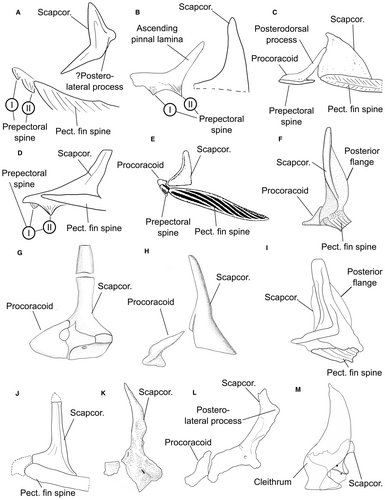
A tall scapular shaft is a synapomorphy of total-group chondrichthyans (Brazeau & Friedman 11), and variation in its morphology is a source of chondrichthyan phylogenetic characters. One possible interpretation of the scapulocoracoid in Vernicomacanthus (Figs 9, 14) is that its scapular shaft possesses a posterolateral angle, a character previously restricted to conventional chondrichthyans but broadly present in the chondrichthyan crown-group. In conventional chondrichthyans the posterolateral angle is present in total-group holocephalans as well as in many Palaeozoic sharks (Dick 35; Coates & Sequeira 28; Coates & Gess 27). Although it is absent in neoselachians this is probably a secondary derivation, because it is present in stem elasmobranchs (Coates & Gess 27). This region of the scapulocoracoid is unknown in the stem-group chondrichthyan Doliodus; a posterolateral angle is present in the possible stem-group chondrichthyan Gogoselachus (Long et al. 60). The mould of the scapulocoracoid of Dobunnacanthus (Fig. 13E, F) lacks a similar structure, as does Climatius (Burrow et al. 21). If a posterolateral angle is present in Vernicomacanthus it suggests two possible most parsimonious histories: it is evidence for either a relatively crownwards placement of Vernicomacanthus in the chondrichthyan stem-group, or an outgroup position relative to an acanthodian clade. However, whether or not this structure is a posterolateral angle in Vernicomacanthus remains uncertain. If, as we suggest alternatively, it is instead a fin articulation, this would be similar to articulations in taxa such as Gogoselachus and Tribodus (Lane & Maisey 59; Long et al. 60), although dissimilar to those of any known acanthodian (Miles 65).
The unusually tall ascending pinnal lamina in the dermal shoulder girdle of Dobunnacanthus is absent in Vernicomacanthus and other stem-chondrichthyans. The only superficially comparable structure is in the procoracoid in gyracanthids, where a tall posterodorsal process extends in front of the scapulocoracoid for most of its length (Warren et al. 88; Turner et al. 85; Snyder et al. 81). Although this is formed from endoskeletal bone and cartilage, the ascending pinnal lamina in Dobunnacanthus is considered to be dermal on the basis of its tuberculated surface. However, dermal bone and endoskeleton often have an intimate relationship in stem-chondrichthyan shoulder girdles. Procoracoids of gyracanthids and Diplacanthus are formed from fused complexes of dermal and presumed perichondral bone (Miles 65). In Doliodus the prepectoral spines are mounted directly on the scapulocoracoid, and it is likely that this was also the case in more heavily armoured taxa (Maisey et al. 62). In Climatius it is unclear whether the ‘plates’ of the dermal shoulder girdle are purely dermal or whether they formed from dermal ossifications pressed onto a perichondral base (Miles 65; Burrow et al. 21). It is thus possible that the ascending pinnal lamina of Dobunnacanthus had an internal perichondral component with tubercles superimposed on its surface and is homologous with the posterior dorsal process of the gyracanthid procoracoid. If true, this may point towards a relatively close relationship between them.
Large pectoral fin spines with nodulate ridges converging on the leading edge of the spine rather than the tip are present in a number of articulated stem-group chondrichthyans. Beyond Vernicomacanthus and Dobunnacanthus they are present in gyracanthids (Warren et al. 88; Turner et al. 85; Snyder et al. 81), as well as in Lupopsyrus, Parexus, and isolated spines attributed to Doliodus (Hanke & Davis 47; Burrow et al. 20, 23). In addition, a row of denticles is on the trailing edge of the pectoral spines of some of these taxa, including Doliodus, Lupopsyrus, Vernicomacanthus, and some Gyracanthides (Gagnier & Wilson 40; Hanke & Davis 47; Burrow et al. 23). These fin spine characters were noted by Burrow et al. (19), who argued that they comprised evidence for a close relationship between Ankylacanthus, gyracanthids, and possibly Vernicomacanthus. In this paper we have also noted several other characters that may imply a relationship between some of these taxa. Many of them have polyodontode scales similar to Vernicomacanthus; although Lupopsyrus has monodontode scales (Hanke & Davis 47), the crowns are markedly similar in shape to the individual crowns in Vernicomacanthus, and monodontody may be linked to its relatively small body size. We have also highlighted possible similarities between the procoracoid of gyracanthids and the ascending pinnal lamina of Dobunnacanthus.
Conclusion
We present new data on the pectoral and dermal skeletons of Vernicomacanthus and Dobunnacanthus gen. nov., taxa that lie at a key phylogenetic juncture in ongoing debates about early chondrichthyan evolution. Several strands of evidence in the scales, spines and shoulder girdle hint at a close relationship between Vernicomacanthus, Dobunnacanthus nov. gen. and gyracanthids. This has not been borne out in recent phylogenetic analyses (e.g. Coates et al. 29) but may emerge with closer attention to stem-chondrichthyan characters. Character states shared by these taxa and some conventional chondrichthyans may suggest a relatively crownwards placement in the chondrichthyan stem-group, or as the sister-group to an acanthodian clade. More broadly they add to the ongoing erosion of morphologies that distinguish chondrichthyans from acanthodians. As the scales of Vernicomacanthus highlight, deciding whether an articulated animal is an acanthodian or a chondrichthyan has in the past been largely subjective, and essentially based on size rather than on a firm character-based definition. Further study seems likely to reveal more shark-like states in acanthodians and heretofore unappreciated acanthodian characters in chondrichthyans such as Tamiobatis and Diplodoselache.
Acknowledgements
We are very grateful to the museum curators who helped with access to material used in this study, particularly Stig Walsh at the National Museums of Scotland, Edinburgh, who kindly loaned a number of specimens and allowed us to prepare them, but also to Emma Bernard at the Natural History Museum, London, David Lampard, at the McManus Museum, Dundee, and John Johnstone, at Montrose Museum, Montrose. Many thanks also to Tom Davies at the University of Bristol, who helped with CT scanning, to Anna Jerve, for help acid-preparing NMS G.2001.7.4, to Tomasz Goral at the Natural History Museum, London, for help with SEM, and to Plamen Andreev and Lisa Schnetz, for useful discussion. We are thankful to Mike Coates and an anonymous reviewer, whose comments improved the manuscript. This work was funded by a European Research Council grant awarded to MDB under the European Union's Seventh Framework Programme (FP/2007-2013)/ERC Grant Agreement number 311092. RPD is supported by the Paris Île-de-France Region, DIM ‘Matériaux anciens et patrimoniaux’- DIM PHARE projet.
Author contributions
MDB, JLdB, CJB, RGD and MJN conceived this project. JLdB made thin sections of the fin spine and produced the images. IJS made thin sections of the scales. RPD produced images of the scale thin sections, carried out scanning of the isolated scale, and took all SEM images. RPD, JLdB, MJN and MDB took photographs. AK segmented the CT scale data. RPD produced all the figures. RPD and MDB interpreted the data and wrote the initial draft of the manuscript. All authors discussed, contributed to, and approved the final version of the manuscript.
Open Research
Data archiving statement
This published work and the nomenclatural act it contains, have been registered in ZooBank: http://zoobank.org/References/2B2755EC-8705-49AD-B051-33DD73FF3868
CT data for this study are available in the MorphoSource digital repository: https://doi.org/10.17602/M2/M351674 (CT image series); https://doi.org/10.17602/M2/M351685 (scale model).



